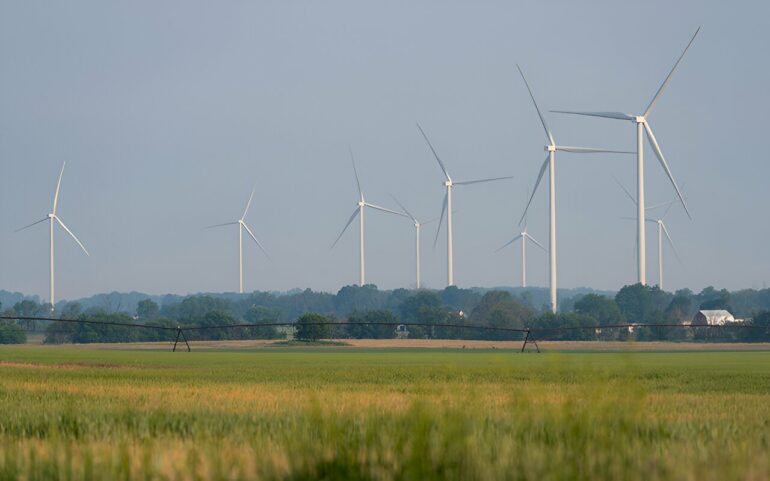The number of local zoning ordinances governing renewable energy deployment is growing in the United States, according to new research by the U.S. Department of Energy’s National Renewable Energy Laboratory (NREL). The amount of land available to deploy renewables depends on the characteristics of the ordinances.
“It’s important to understand the types of ordinances in effect, specifically setback ordinances, or the required distance from a specific feature like a house,” said Anthony Lopez, lead author of a newly published paper that describes the research. “Setback ordinances determine how much land is available for deployment and how much wind and solar resource we have to decarbonize our energy system.”
The impact of setback ordinances has not traditionally been captured in large-scale resource assessments because it requires highly detailed modeling and hyperlocal data. As a result, previous assessments have likely overestimated the amount of land available to renewables and, in turn, underestimated the cost and challenges of achieving high levels of deployment.
State and local zoning laws and ordinances influence how and where a developer can site and deploy new wind and solar projects, supporting the sustainable and responsible development of renewable energy projects. For example, ordinances can establish standards for sound limits and setback distances to ensure the well-being of local citizens. Ordinances can also protect the natural habitats and species where renewable energy projects are deployed and ensure efficient, sustainable use of land resources.
In many places in the United States, zoning ordinances at the county and township level need to be enacted before a large-scale solar or wind facility can be constructed on private land. In these local jurisdictions, decisions are typically made by elected officials following public meetings and input from local citizens and other interested parties.
The NREL study identified 1,853 local wind ordinances in effect during 2022 compared to 286 in 2018. The most common types of ordinances were related to setbacks from structures, roads, and property lines; noise levels; and wind turbine heights.
A first-of-its-kind companion survey of regulations related to the development of utility-scale solar identified 839 ordinances in effect during 2022. The complete findings appear in the Nature Energy article titled, “Impact of Siting Ordinances on Land Availability for Wind and Solar Development.”
“The increase in local zoning ordinances is a sign that the renewable energy industry is maturing,” Lopez said. “Ordinances can provide a structured approach to thoughtfully weave clean energy infrastructure into society and our natural environments.”
Setback distances within the identified zoning ordinances vary considerably across jurisdictions. For wind, the setback is typically determined by a multiplier of the wind turbine’s total height, and for solar, the setback is typically a fixed distance. Researchers found wind and solar resource could be as much as 87% and 38% lower, respectively, under the strictest setback scenario compared to a baseline that does not account for setback ordinances.
Under the most permissive scenario that does not account for setbacks and only excludes legally protected areas and land that is unsuitable for development (because of wetlands, infrastructure, high elevations, or other issues), there is the technical potential of 147 terawatts of solar capacity and 14 terawatts of wind capacity—more than enough to decarbonize the nation’s energy system.
If communities across the country enact setback distances in the 50th percentile, the potential would be lower: 121 terawatts for solar and 4 terawatts for wind. If communities enact the strictest setback distances, the potential for solar could decrease to 91 terawatts and wind to 2 terawatts. That is still enough wind and solar potential to decarbonize the energy system, but the quality and cost of the remaining wind and solar resources will determine how much they are leveraged in the pursuit of decarbonization.
The results indicate that local land use and community considerations play a significant role in U.S. decarbonization and should therefore be accurately reflected in modeling and analysis.
“It’s really important that we understand the impacts of renewable development on communities and provide information that helps them develop ordinances that balance regulation of the real impacts of renewable energy development while enabling deployment and the benefits of that deployment,” Lopez said.
Lopez’s co-authors, all from NREL, are Wesley Cole, Brian Sergi, Aaron Levine, Jesse Carey, Cailee Mangan, Trieu Mai, Travis Williams, Pavlo Pinchuk, and Jianyu Gu.
More information:
Anthony Lopez et al, Impact of siting ordinances on land availability for wind and solar development, Nature Energy (2023). DOI: 10.1038/s41560-023-01319-3
Provided by
National Renewable Energy Laboratory
Citation:
Analysis quantifies impacts of setback ordinances on land available for renewable energy deployment (2023, August 4)



